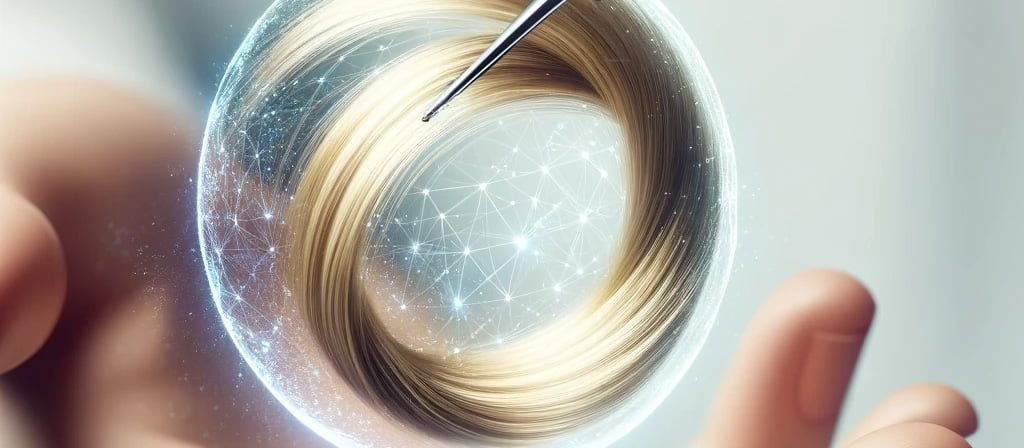Unlocking the Secrets of Hair Elasticity: A Scientific Exploration
Have you ever wondered what gives your hair the ability to stretch and bounce back? The key lies in understanding hair elasticity science, a fascinating aspect of hair health often overlooked. This remarkable characteristic of hair isn’t just a trivial feature; it’s central to maintaining luscious, healthy locks. By delving deeper into its science, we uncover valuable insights that can revolutionize our hair care approach.
Hair elasticity, in its essence, is about how much your strands can stretch and return to their original shape without breaking. It’s an intriguing phenomenon that directly links to the vitality of your hair. When we talk about elasticity, we refer to a vital sign of your hair’s strength and condition. To grasp this concept better, consider exploring our section on Understanding Hair Anatomy, which lays the foundation for comprehending the intricate details of hair structure.
Understanding the importance of elasticity is critical for healthy hair. It’s not just a measure of how well your hair can withstand styling or environmental stress; it reflects its overall health. Elasticity indicates the robustness of your hair and its ability to maintain integrity under strain. For a comprehensive understanding of how elasticity plays into the larger picture of hair health, take advantage of our articles on the Hair Growth Cycle and Common Hair Problems and Solutions, which provide a broader perspective on maintaining optimal hair health.
The Science Behind Hair Elasticity
The core of hair elasticity hinges on the health of your hair’s cortex, the innermost layer that is pivotal in determining strength and flexibility. When exploring the science of hair elasticity, we look at how the cortex’s composition impacts hair’s ability to stretch and bounce back. This layer is composed of long keratin protein chains intricately bound together. Please review our comprehensive guide on Understanding Hair Anatomy for a deeper dive into the cortex’s structure and function.
The structural integrity of hair is mainly dependent on the keratin protein chains and the various types of bonds that hold them together. These bonds – including hydrogen and disulphide bonds – are crucial in maintaining hair’s elasticity. When these bonds are healthy and intact, your hair demonstrates excellent elasticity, signifying robust health.
It’s fascinating to observe how hair behaves differently when it’s wet compared to when it’s dry. When wet, the hair’s bonds temporarily loosen, allowing more stretch. As it dries, these bonds reform and the hair retracts to its natural length. This dynamic change underscores the importance of maintaining an excellent moisture-protein balance in your hair.

Factors Affecting Hair Elasticity
Several factors can impact your hair’s elasticity, each playing a significant role in how your hair behaves and responds to different treatments and environments. First and foremost is the level of moisture. Hydration is paramount in maintaining hair elasticity. Dry, brittle strands are a clear sign of compromised elasticity, lacking the necessary humidity to stretch and return to form. This is why incorporating hydrating products into your routine is essential. Our guide on Shampoos & Conditioners: Choosing the Right One offers a selection of products designed to enhance moisture balance in your hair.
Another critical factor is the protein balance in your hair. Proteins, particularly keratin, are the building blocks of your hair, providing it with the strength and resilience needed to maintain elasticity. Protein treatments can be particularly beneficial for those with high porosity hair, which we discuss in detail in Managing Hair Porosity. They help restore and maintain elasticity by reinforcing the hair’s natural structure.
Finally, the impact of chemical treatments and heat styling must be balanced. Frequent colouring, perming, or heat styling tools can weaken your hair’s natural bonds, thus diminishing its elasticity. As detailed in our article on Protecting Hair from Heat Damage, it’s essential to understand the right tools and techniques to mitigate these effects. By being mindful of these factors, you can take proactive steps to preserve and improve your hair’s natural elasticity.

Testing Your Hair’s Elasticity
Testing your hair’s elasticity is a simple yet revealing process. It’s a practical way to gauge the health of your hair. To conduct this test, gently stretch a wet strand of hair and observe its response. Healthy hair should stretch up to 50% of its original length when wet and about 20% when dry before returning to its natural state. This stretchability is a testament to robust and well-maintained hair. If your hair breaks easily or fails to return to its original length, it indicates poor elasticity and may need more nourishment and care.
For a deeper understanding and practical tips on how to test hair elasticity, our dedicated article on this topic provides a comprehensive guide. Additionally, exploring the relationship between hair elasticity and health can offer further insights into how your hair’s condition reflects its overall health. This knowledge guides you in choosing the right treatments and products.
Improving hair elasticity involves a holistic approach to hair care. Incorporating natural remedies, as discussed in our Natural Remedies for Hair Elasticity section, can provide your hair with the gentle, effective care it needs. From homemade masks to herbal treatments, these natural solutions enhance your hair’s elasticity and overall health.

Improving Hair Elasticity
Enhancing your hair’s elasticity isn’t just about external treatments; it’s deeply connected to your overall lifestyle and dietary choices. A balanced diet, rich in proteins, vitamins, and minerals, is fundamental to maintaining healthy hair. Proteins are essential as they are the main components of hair. Foods rich in omega-3 fatty acids, biotin, and antioxidants can significantly improve hair strength and elasticity. Our section on Hair Care for Children offers excellent insights into how a balanced diet can positively impact hair health from a young age.
Gentle handling is another critical factor in preserving hair elasticity. Minimizing damage from physical stress is crucial. This includes being careful with wet hair, which is more prone to damage, and using suitable combs and brushes. Our guide on Basic Hair Styling Techniques provides practical advice on how to style your hair without compromising its health and elasticity.
Advanced treatments and specialized products can provide substantial benefits for those seeking to elevate their hair care regimen. Incorporating leave-in conditioners and serums can offer ongoing hydration and protein support, which is crucial for maintaining elasticity. These products lock in moisture and nutrients, keeping hair flexible and resilient. Furthermore, applying a good heat protectant is essential if you frequently use heat styling tools. These products form a protective barrier on the hair shaft, reducing the risk of damage while maintaining elasticity. For more on this, our article on Protecting Hair from Heat Damage is a valuable resource.
Advanced Care for Hair Elasticity
Understanding the various hair types and their unique elasticity needs is crucial for effective hair care. Each hair type – straight, wavy, curly, and coily – has its distinct structure and thus requires different approaches to maintain elasticity. Curly and coily hair types, in particular, often require more moisture due to their shape and texture, leading to more dryness and susceptibility to breakage. Our detailed guide in the Identifying Your Hair Type section can help you understand your specific hair type and its needs.
Furthermore, hair elasticity varies with hair type, age, and health factors. Hair loses its elasticity as we age, becoming more prone to breakage. Similarly, health conditions and hormonal changes, as discussed in our Hair Care During Pregnancy section, can significantly affect hair’s elasticity. Awareness of these changes and adapting your hair care routine is vital to maintaining healthy and elastic hair throughout life.
Understanding hair elasticity science is not just about knowing how your hair behaves; it’s about taking the proper steps to nurture and protect it. By following the tips and information in this article and exploring related sections such as Hair Care for Men and Hair Care for Children, you’re on your way to healthier, more resilient hair. Remember, every hair type has unique needs for maintaining elasticity, and listening to your hair and treating it with the care it deserves is fundamental. This knowledge will improve your hair’s health and enhance your overall hair care experience.

Understanding Different Hair Types
Remember, every hair type, from straight to coily, has unique needs for maintaining elasticity. Listening to your hair and treating it with the care it deserves is crucial for its health. By embracing the knowledge about hair elasticity and applying the proper practices, you not only improve the health of your hair but also enrich your entire hair care experience.
The science of hair elasticity is a powerful tool in your hair care arsenal. It provides you with a deeper understanding of the nature of your hair and enables you to make informed decisions about products and treatments. For instance, learning about the relationship between hair moisture and elasticity can help you choose the right products to maintain a healthy balance. Additionally, understanding how the hair cortex and elasticity are interrelated offers a more detailed perspective on the hair’s internal structure and how to keep it healthy.
Ultimately, a comprehensive understanding of hair elasticity empowers you to effectively care for your hair, whatever your hair type or unique challenges. Whether you are exploring protein treatments for hair elasticity or seeking natural remedies to improve hair elasticity and porosity naturally, this knowledge will guide you toward the best practices and products.
Conclusion
The science of hair types and elasticity care extends beyond just understanding hair behaviour; it involves a proactive engagement in nurturing and protecting your hair. Insights from research reveal the importance of various factors influencing hair health and elasticity. For instance, studies have shown that hair strength and elasticity are influenced by diet, age, oil application, and pigmentation. Children’s hair, for example, has been found to have more excellent elasticity than adult hair, although the tensile strength doesn’t significantly vary with age (Kavitha et al., 2016). Additionally, the mechanical properties of hair, such as tensile strength and elasticity, differ across various hair diseases, further highlighting the need for a tailored approach to hair care (Swanbeck et al., 1970).
Moreover, advancements in hair care technology and products continuously enhance our ability to maintain healthy and elastic hair. Nanoindentation and scanning electron microscopy (SEM) studies have provided an in-depth understanding of hair’s nanomechanical properties, offering insights into the effects of cosmetic products on hair health (Wei et al., 2005). Furthermore, atomic force microscopy has allowed researchers to explore hair’s structural, mechanical, and tribological properties, which is crucial for developing better cosmetic products (Bhushan & LaTorre, 2010).
By integrating these scientific insights into our daily hair care routines, we empower ourselves to make informed decisions. Whether it’s improving hair elasticity naturally or choosing treatments that target the hair cortex, knowledge from scientific research becomes a cornerstone of effective hair care, leading to more robust, more elastic, and healthier hair.
